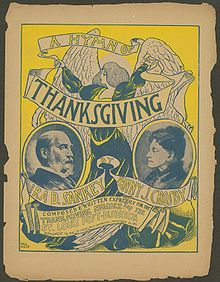
Quick Facts
Biography
Ira David Sankey (August 28, 1840 – August 13, 1908), known as The Sweet Singer of Methodism, was an American gospel singer and composer, associated with evangelist Dwight L. Moody.
Early years
He was born on August 28, 1840 in Edinburg, Pennsylvania, just outside New Castle to David Sankey and Mary (née Leeper).
Personal life
Aged 16, Sankey was converted at a revival meeting at the King's Chapel (now a United Methodist Church), three miles away from his home. He served in the Civil War as a young man, later taking employment at the Internal Revenue Service, and also the YMCA. He married Fanny Victoria Edwards, one of his choir members, in September 1863; the couple had sons, John Sankey (1868–1912), and Ira Allan Sankey.
Musical career
Sankey's increasing fame as a Gospel singer eventually attracted the attention of noted evangelist Dwight L. Moody. They first met at a YMCA convention in Indianapolis, Indiana, in June, 1870. Several months later, Sankey attended his first evangelistic meeting with Moody. Shortly thereafter, Sankey resigned his government position.
In October 1871, Sankey and Moody were in the middle of a revival meeting when the Great Chicago Fire broke out. The two men barely escaped the conflagration with their lives. Sankey ended up watching the city burn from a rowboat far out on Lake Michigan. On June 7, 1872, Sankey and Moody made the first of several joint visits to the UK. Sankey's hymns were promoted by London Baptist preacher, Charles Spurgeon, long afterwards. While in Edinburgh, they raised £10,000 at a fundraiser to build a new home for the Carrubbers Close Mission, and the foundation was laid during their time in Edinburgh. Today, the building remains one of the few on the Royal Mile still serving its original purpose.
When a local pastor asked Rev. Moody about the contribution that a gospel singer and song leader such as Ira Sankey brought to his meetings, Moody replied, "If we can only get people to have the words of the Love of God coming from their mouths it's well on its way to residing in their hearts."

Sankey wrote several hymns and songs, and composed and arranged music for many more. He collaborated with Philip Bliss and then later with James McGranahan and George Stebbins) on a series of "sacred song" collections published in the United States by Hubert Main through his Biglow & Main Co., and in the United Kingdom by Morgan & Scott, publishers also of his most enduring work, the popular Sacred Songs and Solos(widely known as "Sankey & Moody") which eventually ran to over 1200 works and is still in use today. Sankey served as Biglow & Main's president from 1895 to 1908. He also worked with one of the company's most prolific hymnwriters, Fanny Crosby, who became his friend and music-making partner.
His first and most famous composition was 'The Ninety and Nine'. Sankey and Moody were en route from Glasgow, Scotland to Edinburgh in May 1874, as they were to hold a three-day campaign there. This was at the urgent request of the Ministerial Association. Prior to boarding the train, Sankey bought a weekly newspaper for a penny. He found nothing of interest but a sermon by Henry Ward Beecher and some advertisements. Then, he found a little piece of poetry in a corner of one column that he liked, and he read it to Moody, but only received a polite reply. Sankey clipped the poem and tucked it in his pocket. At the noon day service of the second day of the special series, Moody preached on The Good Shepherd and asked Sankey if he had a final song. An inner voice prodded him, although there was no music to the poem, so he acquiesced. He placed the little piece of newspaper he had tucked in his pocket on the organ in front of him. Half speaking and half singing, he completed the first stanza, which was followed by four more. Moody walked over with tears in his eyes and said, "Where did you get that hymn?" The Ninety and Nine became his most famous tune and his most famous sale from that time on. The words were written by Elizabeth Clephane in 1868; she died the following year.
Death and legacy
Glaucoma blinded Sankey during the last five years of his life, so Crosby, blind since childhood, may have also been a kindred spirit.
Sankey died on August 13, 1908 at his home in Brooklyn, New York. He was buried at Green-Wood Cemetery in Brooklyn. His wife died in 1910 and their son John in 1912. Thus, in 1923, upon discovery of a bank account in his name, his will was probated 15 years after his death.
In 1979–80, the Gospel Music Association recognized Sankey's prodigious contributions to gospel music by listing him in the Gospel Music Hall of Fame.

 Virgo
Virgo